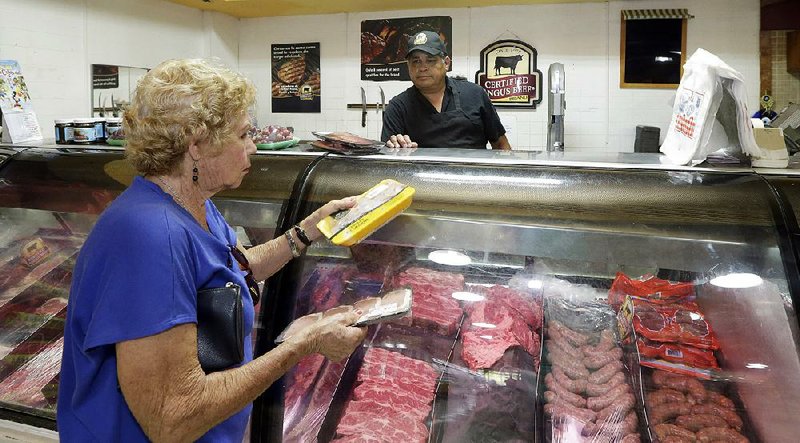WASHINGTON -- Consumer spending in June rose by the smallest amount in four months as shoppers cut back on purchases of cars and other big-ticket items.
Consumer spending edged up 0.2 percent in June, the poorest showing since a similar increase in February, the Commerce Department reported Monday.
The modest advance comes after a revised 0.7 percent rise in spending in May. The increase had been driven by heavy spending on autos. But in June, auto sales slowed. Overall purchases of durable goods, the category that covers autos, fell 1.3 percent in June.
Personal income rose 0.4 percent for a third straight month, reflecting strong employment gains.
"Wage growth is still a bit of an issue -- you're really not seeing a whole lot of acceleration," said Gennadiy Goldberg, a U.S. strategist at TD Securities LLC in New York, who correctly projected the rise in consumer purchases. While the June figures show "a little bit weaker hand-off into the third quarter," he said, "overall, we're chugging along pretty decently here."
Economists didn't appear too concerned about the June spending slowdown.
"We still expect that a strengthening labor market will support spending growth in the second half of the year," said Paul Dales, senior U.S. economist at Capital Economics.
He said he was looking for a solid gain in jobs of around 250,000 in July, which will help fuel further income gains. The government will report on July employment on Friday.
With income rising faster than spending, the personal saving rate climbed to 4.8 percent of after-tax income from 4.6 percent in May.
An inflation gauge closely watched by the Federal Reserve rose by 0.1 percent in June, the same as in May. Over the past 12 months, this price gauge is up just 0.3 percent, reflecting big declines in oil prices. Prices excluding food and energy are up just 1.3 percent.
Those figures are well below the Fed's 2 percent target for annual increases in inflation.
For the full April-June quarter, consumer spending posted a solid gain, rising at an annual rate of 2.9 percent, much stronger than the 1.8 percent growth rate for spending in the first quarter.
The Federal Reserve last week cited gains in consumer spending, the labor market and housing as evidence the economy is improving. But Fed officials kept a key borrowing rate at a record low near zero, where it has been for almost seven years.
Economists believe further gains in the economy and an acceleration of inflation, which has been running below the Fed's 2 percent price target, will prompt officials to begin raising rates later this year.
Some analysts say the first rate increase will occur at the next Fed meeting on Sept. 16-17, while others believe it could be December before Fed officials will feel confident enough about the economy.
U.S. construction spending increased in June by the smallest amount in five months as a big drop in nonresidential building activity offset a third straight increase in home building.
Construction spending edged up a slight 0.1 percent in June after a 1.8 percent increase in May and a 3.8 percent rise in April, the Commerce Department said Monday. Even with the June slowdown, construction spending advanced to a seasonally adjusted annual rate of $1.06 trillion, the best pace in seven years.
Residential construction expanded 0.4 percent in June. But nonresidential building slipped 1.3 percent, with the category that covers shopping centers sliding 4.4 percent. Spending on government building projects was up 1.6 percent as a solid increase at the state and local levels offset a drop in federal projects.
Construction is expected to provide support for the overall economy this year, led by gains in housing activity.
Residential construction grew at a solid annual rate of 6.6 percent in the spring.
Economists believe activity will strengthen further in the second half, helping to push growth to around 3 percent in the third and fourth quarters of this year.
U.S. factories were a little less busy last month.
The Institute for Supply Management's manufacturing index slipped to 52.7 last month from 53.5 in June. Economists had expected the index to remain unchanged. Any reading above 50 indicates growth.
The index had risen in May and June before slipping last month. It hit a 12-month high of 58.1 last August.
Factories' exports are contracting, partly because a strong dollar makes U.S. goods more expensive.
"There are a lot of things that are weighing on exports," said Bradley Holcomb, chairman of the institute's manufacturing business survey committee. He cited the strong dollar, China's economic slowdown and uncertainty about a resolution to the Greek debt crisis.
Hiring slowed at U.S. factories last month, but production and new orders rose.
"The manufacturing sector will probably continue to struggle as the dollar has appreciated further recently and overseas demand has remained muted," Adam Collins, an economist at Capital Economics, wrote in a research report. "However, activity in other, larger parts of the economy has remained strong."
Information for this article was contributed by Martin Crutsinger and Paul Wiseman of The Associated Press and Michelle Jamrisko of Bloomberg News.
Business on 08/04/2015

